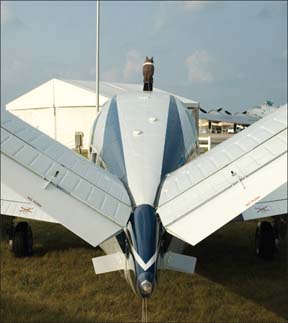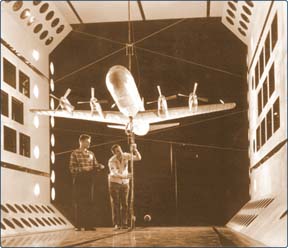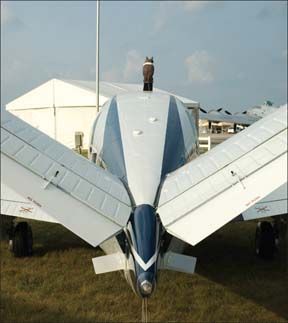
by Jeff Pardo
Youre descending at a relatively high speed in calm air and, since there was no forecast for and little chance of turbulence, you let the airspeed climb into the yellow arc. Then you hear a buzzing noise. You might think that one or more fasteners have come loose, perhaps on the cowling-or you might imagine a bee, wasp or some other stowaway insect as the source. One thing is for sure; the sound you hear probably isnt a stuck microphone. So whats going on? Well, you had better slow down, because that buzz you hear could be your ailerons about to go fully into auto-flail mode.
As amusing as that expression may sound, such an event, were it to occur to you, would quite likely provide you with your first and very last encounter. There is one single unassuming word that is used to refer to it, and the first time someone new to aviation ever hears it, theyre usually surprised because of its misleadingly serene and delicate name. The word is flutter.
So What Is Flutter?
Flutter occurs as a result of interactions between aerodynamic and inertial forces. Flutter can involve a wing, ailerons, elevators/ruddervators and other aircraft structures. For an aircraft wing, flutter may occur when the aircraft is accelerated to a speed where, when even slightly disturbed, the wings flex, and the resultant vibrations do not have sufficient damping, or are in fact intensified by inherent resonance frequencies. Here is how it works with the simplest two-dimensional case of bending/torsion flutter involving an airplane wing. (Torsion is just a fancy word for twisting.)
When a wing hits a gust, it experiences an increase in lift. This causes the wing to flex upwards, as you would expect. However, for many wings, due to the location of the center of pressure, this upward bending along its span is often combined with torsion. This twists the wing in just the same way (but nowhere near as much) as the built-in twist of your propeller blades.This resulting torsion changes the wings angle of attack, in turn reducing the amount of lift generated, causing the wing to swing back downwards after completing its upswing. At the lowest point, the wing begins to twist back up again.
This happens naturally to an aircraft in flight, but in the case of flutter, the vibrations are divergent-each oscillation builds upon or adds to the previous one-and the increasing flexure can reach the point where the wing just rips right off. They dont have to be wings, either.
A famous case of aerodynamic flutter involved the Lockheed Electra. On September 29, 1959, a Braniff Airlines Electra broke apart between Houston and Dallas, Texas. Then, on March 17, 1960, an Electra operated by Northwest Orient, en route from Chicago to Miami, Florida, broke apart over Perry County, Indiana. Subsequent investigation blamed propeller whirl for creating a flutter condition in the Electra, leading to in-flight wing separation.
Not Just Aircraft
Many everyday things, aside from metronomes and pendulums, have resonance frequencies. If your kids slosh the water in your bathtub at the right frequency (around one Hertz (or slosh per second), things can get out of control in a hurry. The famous 50-foot tides in the Bay of Fundy in fact are due to the shape and size of the basin being such that resonant frequencies create a co-oscillation in synch with the 12-hour, 25-minute tidal period.
A similar thing can occur in lakes called a seiche (pronounced SAY-sh), which is the formation of standing waves (resulting from earthquakes or wind) in a body of water, due to wave formation and subsequent reflections from the ends. Its just sloshing on a bigger scale. (In 1954, a seiche that was eight feet high and 25 miles wide hit Chicagos lakefront, and it resulted in the drowning of eight people.) The famous case of the Takoma Narrows Bridge tearing itself apart in 1940 is another example of resonance frequencies and flutter, again on a larger scale.
The moral is that everything on an airplane has an inherent vibration frequency. Go fast enough, and something will start behaving like a flag in a stiff breeze. Im as patriotic as the next guy, but this is not a good thing.
Certification Testing
In-flight flutter testing is required for certification of an aircraft. The aircraft is required to be safe up to something known as the design diving speed, or VD (and which is actually about 11 percent higher than even VNE).At that point, an outside force simulates a wind gust to provide sufficient excitation that, if flutter were possible at this speed, it would be induced.Accelerometers or strain gauges on the wing, tail, fuselage and control surfaces provide data for the test engineers, and their feedback is analyzed for unstable indications.

The outside force could be a small rotating vane or oscillator on a wingtip, or the pilot simply tapping the controls. Incidentally, if theres so much air resistance that the airplane cant reach VD even when its pointed straight down, then the test pilots top speed becomes the demonstrated diving speed, known as VDF, and our top speed of VNE can in turn be no more than 90 percent of VDF (of which that 11 percent mentioned above is the reciprocal).
In a car, a slightly out-of-balance tire that begins to wobble at 50 mph, gets worse at 55, and dissipates by 60 isnt much more than a reminder to visit the shop soon. An airplane, though, with its inherent structural concessions for the sake of weight, isnt so overbuilt. This is the main reason we have a yellow arc in the first place. When the air is dead calm, the safety margin against divergent oscillation is much greater. But any sudden gusts, and you become a test pilot. Add in an imbalance in the ailerons-for example, if just one small counterweight came loose-and youve just installed a wingtip oscillator. Other maintenance-related problems or skin damage can also induce flutter. So if you ever find yourself feeling like theres a whole lotta shaking going on, level the wings (if they arent already), reduce power and gently raise the nose to slow down.
Excess Airspeed
Weve all been warned to watch out whenever our airspeed enters the yellow arc, and weve learned to absolutely stay away from never-exceed speed, VNE.Whenever a discussion about excess airspeed comes up, the first thing we usually think of involves the g-loads exacted by turbulence. There is another reason behind that, just as potentially catastrophic, which involves this flutter thing. Evocative perhaps of a gently quivering feather, or among audiophiles perhaps suggestive of an audiotape with an inconstant speed-if youre a cardiologist, its something worse-it is also a dangerous phenomenon encountered in flexible structures including buildings, telegraph wires, and bridges (and of course, airplanes) whenever they are subjected to aerodynamic forces.
Due to their innate flexibility, and the amounts of aerodynamic loads airplanes can sustain, flutter is something that definitely merits our attention. Also, flutter may be the demon at the end of the airspeed spectrum after VNE, but dont forget that even well before that red line, at the beginning of the yellow arc at VNO, maximum structural cruising speed, FAR 23 only requires airplanes to withstand about a 30-knot gust (50 fps), and tolerance drops off rapidly after that.
But with apologies to Muhammad Ali for borrowing and then mutilating his famous quote-float like a butterly; sting like a bee-this is one butterfly that can inflict a mortal wound to your aircraft.
What To look For
It isnt my intention to add unwarranted apprehensions to a world already filled with enough of them, but the fact is that a cursory outside inspection wont always reveal that your aircraft might be a candidate for self-destruction. This is because a flutter-inducing imbalance doesnt have to be on the outside: Poorly rigged control rods and slack cables can cause a very unwelcome sort of wiggle room, also.
This is one strong motivation for a good preflight check that tabs, cables or push rods arent loose, because if they are, they can induce flutter.Cables usually have problems such as insufficient lubrication and tension, as well as corrosion.
Another thing to look for during your preflight, of course, would be an imbalance caused by missing counterweights on your ailerons. In airplanes that fly high, cables can cause problems as the airframe gets cold-soaked and shrinks at a greater rate than does steel cabling. Since cable tensions are compromised, so are the safety margins against flutter. Pulleys that arent adequately lubricated can seize, become worn due to cable friction, or cut through the cable altogether. Problems related to rigging can also result in uncoordinated flight, such as with improperly tensioned or mismatched cables.The pushrod system can also degrade through neglect however, such as with corrosion at pushrod pivots, or insufficient lubrication on elevator trim jackscrews, but overall, theyre the tougher of the two.
What To Do
If you ever do have such a problem and you hear such a noise, consider yourself fortunate, because although aileron buzz usually exists in transonic airplanes, and is generally not an automatic precursor to flutter, it can precede structural failure in even an ultralight aircraft.
The buzz usually refers to a rapid oscillation of a control surface, most often an aileron, which doesnt usually attain a large amplitude or become dangerous, and is caused in most cases by shock-induced separation of the boundary layer at high transonic speeds.
True, the ailerons of certificated light planes are not supposed to exhibit aileron buzz even at never-exceed speed (red line), but it can-and it has-happened. The reason can be an imbalance condition or problem in the control cables, for example.
Nonetheless, if you even think that you hear any sudden high-frequency vibration, you may have just become a test pilot, and the only correct thing to do is to slow down.
Also With This Article
“The Stinging Butterfly”
“History Of Flutter Testing”
“Real-World Flutter”
-Jeff Pardo is a freelance writer and editor who holds a Commercial certificate for airplanes, helicopters and sailplanes.




